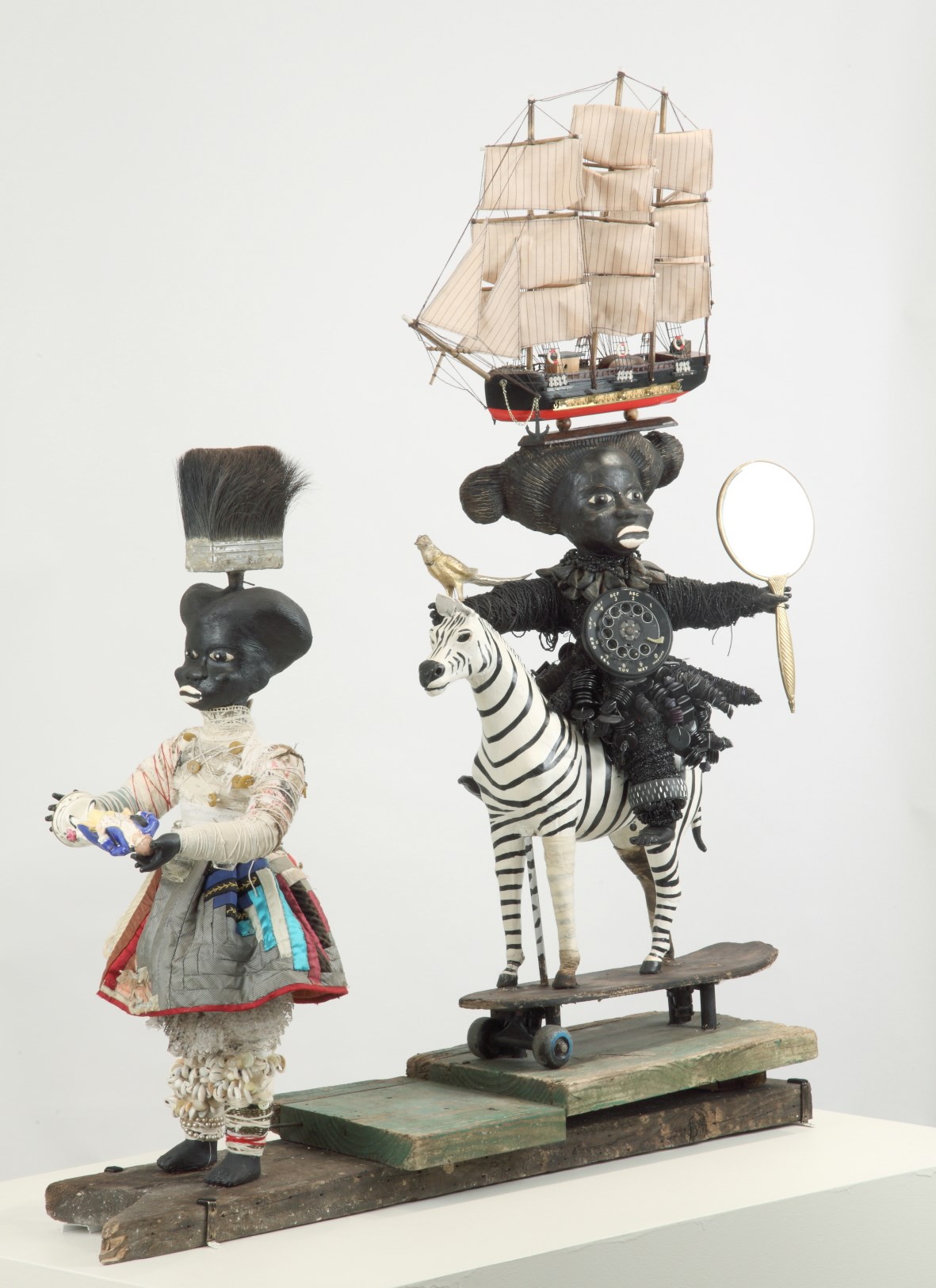—
A Complement to African American Art in the 20th Century
To complement the exhibition African American Art of the 20th Century from the Smithsonian American Art Museum, we have brought together a selection of paintings, sculptures, photo montages and prints from The Westmoreland’s permanent collection and loans from Art Bridges and The University Museum at Indiana University of Pennsylvania.
The nine artists in this special focus exhibition: Tina Williams Brewer, Willie Cole, David Clyde Driskell, Vanessa German, Charles ‘Teenie’ Harris, Kerry James Marshall, Thad Mosely, Joe Overstreet, and Mickalene Thomas, explore their own personal histories, their heritage, and art history in a range of media and approaches.
Works from The Westmoreland’s Permanent Collection
Thad Mosely is a self-taught sculptor giving new life to “at hand” materials such as stone from demolished buildings, scrap yard metal, and most often, logs from the trees of western Pennsylvania. He draws with hammer and chisel, embarking on a journey of sculptural improvisation. Each log suggests what it wants to be. What begins as a suggestion in chalk directly applied to the wood evolves into an elegant balance of space and structure. Material guides the artist through months of creation as sturdy roots are replaced with an airy fluidity that seems to contradict the heft of its natural state. His Cloud, 2010, while made of a heavy piece of cherry, delicately balances on its arched support, floating just above our heads.
Vanessa German’s Parade to the Baptism, 2013, is reminiscent of Central Africa’s nkisi nkondi. Referred to as ‘Power Figures,’ they are embodied with a spiritual mysticism intended to protect a community in the midst of turmoil. The artist adorns her figures with items she is drawn to – sometimes subconsciously plucked from the sidewalk, other times scavenged from the wrong side of police crossing tape. Her assemblages speak to the African American experience, the hand-me-down sorrows of generations past, and the hopeful prayers for a thriving future. Everything means something.
Mickalene Thomas draws on art history and popular culture to create a contemporary vision of female sexuality, beauty, and power. Thomas constructs complex portraits, landscapes, and interiors in order to examine how identity, gender, and sense of self are informed by the ways in which women are represented in art and popular culture. In Shug Kisses Celie, 2016, Thomas photographed a still from the movie The Color Purple, a complicated tale of male dominance, female empowerment and the healing power of love.
Works on Loan from Art Bridges
David Clyde Driskell uses oil and collage to allude to his own personal history, African and ancient art, and the natural landscape. While he references multiple styles in his work, his primary language is the flattened and overlapping planes of Cubism and the painterly brushwork of Abstract Expressionism. Collaged elements, including paper and cloth, comprise the woman’s head and body in Woman With Flowers, 1972, while a loosely-defined cross makes up the space behind the figure. Holding an armful of multi-colored flowers, she appears Madonna-like in her pose. Driskell fondly remembers the quilts that his mother and other female family members made, so the grid of squares that form the cross pattern could be a reference to her as well as alluding to his father who was a Baptist minister. Collage is fundamental to Driskell’s artistic process and he acknowledges the work of Romare Bearden (whose two paintings will be on view in the Cantilever Gallery), whom he met the year after this painting was made, and had long-admired. Driskell referred to Bearden as a “great American master.”
For Boxes, 1970, Joe Overstreet (1933-2019) takes abstract painting into the sculptural dimension. Held in place by rope tension lines, Overstreet removes his canvas from its stretcher, suspending it in mid-air. His contemporary and friend, Sam Gilliam (who has three paintings that will be on view in the Cantilever Gallery), comes to mind when seeing Overstreet’s work. Known too for removing any supports from his large shaped canvases, Gilliam lets them hang freely on the wall. Overstreet saw his sculptural paintings as experiments in how to situate art and viewers in physical space, allowing them to interact directly with his work. “My paintings don’t let the onlooker glance over them, but rather take them deeply into them and let them out—many times by difference routes.”
In Lost Boys: AKA BB, 1993, Kerry James Marshall uses acrylic and collage to create his memorial to the deaths of black youths by gun violence. Conceived and painted years before Trayvon Martin, Michael Brown, Tamir Rice, Antwon Rose, and so many others lost their lives, Marshall reflects the bitter reality of life for young black men in this country, still happening all too frequently even 27 years later. With the other artists in this exhibition, he shares excerpts from his personal history, African American history, and art history. According to Holland Cotter, Marshall has “become one of the great history painters of our time.” He refers to Marshall as an “ace storyteller.” “Sometimes he spells the story out and other times only implies the story. (“Kerry James Marshall: Mastry,” New York Times, 10/20/16)
Works on Loan from The University Museum
Willie Cole takes everyday domestic objects (flat irons, shoes, plastic bottles, ironing boards to name just some) and transforms them for the viewer to reinterpret. Cole found an iron on the street that had been run over. He no longer saw it as an iron but as an African mask, transforming that simple shape into something much more powerful.
With special thanks to Art Bridges and The University Museum at Indiana University of Pennsylvania, for their generous support of this exhibition.
![]()
